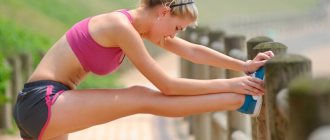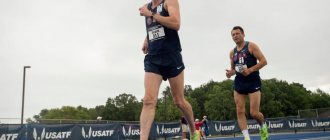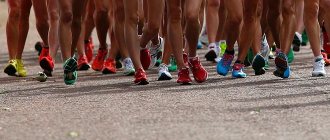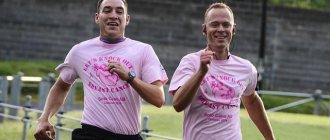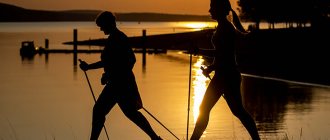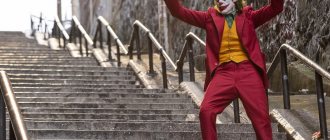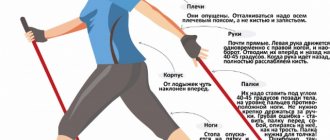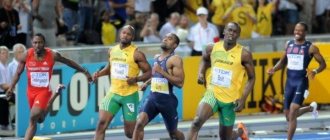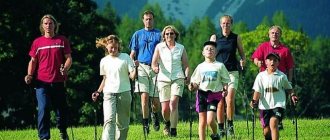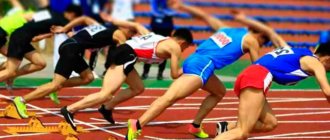Differences between race walking and running
Race walking differs from running in three key ways:
- technique;
- rules;
- speed.
These differences are especially clearly visible during athletics competitions, where you can see all the nuances of a particular discipline.
- In race walking, the athlete takes each step with a full foot, and one leg is always in contact with the surface, while in running, both legs are in the so-called “flight phase” between pushes.
- The walker's starting position is always upright, while runners may take a low starting position.
- According to the rules of race walking, the athlete must step on a straight leg, while in running - on a bent one.
| running speed | speed in race walking |
| from 16 km/h for long, up to 30 km/h for short | 8-10 km/h, professionals reach speeds of up to 16 km/h |
Compared to running, race walking is a less traumatic sport, since walking puts less stress on the leg than in running disciplines.
Kinds
We studied what race walking is and how to walk correctly, but did not consider its varieties. Let's list them briefly:
- Slow pace - speed is approximately 80 steps per minute;
- Medium - 120 steps per minute;
- Sports - 150 steps per minute. At this speed, 1 kilometer travels in 7 minutes. This is the pace that is considered ideal for participating in long-distance competitions;
- Fast pace - it is practiced only by experienced athletes, their average speed reaches 10-16 km/h.
The benefits of race walking
Race walking is not necessarily a professional sport. Many people today use race walking as a recreational activity. The beneficial effects of race walking on the human body:
- normalization of the cardiovascular system;
- improving the functioning of the respiratory system;
- normalization of the gastrointestinal system;
- increasing stress resistance of the nervous system;
- reduction in subcutaneous fat levels;
- toning almost all muscle groups.
Walking: Pros and Cons
The magical benefits of walking are as follows:
- Burning calories . We ate a piece of cake, then it’s time to walk at a brisk pace for 5–10 kilometers.
- No shock load . When walking, there is no flight phase - and therefore no impact when landing.
- Blood circulation is stimulated.
- An excellent remedy for combating glaucoma .
- The heart muscle is strengthened , blood pressure is stabilized, and the heart rhythm is equalized. The load is low-pulse, which is very useful.
- The level of “bad” cholesterol decreases.
- Lung function is restored . The body is freed from toxins and waste products.
- Improves intestinal motility.
- Increases muscle tone.
- Good diabetes prevention.
- You can make new acquaintances.
And now the cons:
- The load is low intensity . Low training effect, long absence of visible results.
- Few calories are burned.
- It's difficult to tone your body.
- Longer in time.
History of race walking
The first official race walking competition took place in London in 1882. It was continuous walking for 5 hours.
Race walking was first included in the Olympic program in 1932 (distance 50 km), and in 1956 race walking 20 km became an Olympic discipline. Since 1992, the program of the Olympic Games has included women's race walking competitions over a distance of 20 kilometers. The 10-kilometer distance was included in the program of two Olympic Games: 1992 and 1996.
Correct body position
Walking will only benefit you if you maintain proper body posture. Namely: the feet should be exactly hip-width apart, the toes of the shoes “look” straight ahead.
Bend your elbows at an angle of 90 degrees, pressing your elbows to your body. Bring your shoulder blades together and stick out your chest! But your shoulders need to be lowered and pulled back a little.
Tighten your abdominal muscles, as if you were doing Pilates (squeeze your pelvic floor muscles and zip up your stomach).
To avoid getting bored, turn on your favorite music in the player. You can buy a small device. which hangs on your belt and counts the steps and kilometers you have walked. It's called a pedometer and is sold at any sporting goods store.
And remember: the average speed of a person when walking, if you want to get a healing effect, should be at least 4-5 km/h!
Race walking for weight loss
Race walking, like running, is an excellent tool for combating excess weight, but it is much less traumatic and has fewer contraindications.
- Start at a slow pace, the pulse should increase smoothly, gradually. Slow down also slowly and progressively;
- Do aerobic warm-up before walking and stretch after exercise;
- Pay special attention to your body position and movement technique in all phases;
- Drink water before and after exercise, and during exercise, wet your mouth with water if necessary;
- Choose the right shoes and clothes for race walking so that you don’t feel discomfort during training;
- Breathe correctly through your nose, continuing to monitor your pace;
- Do race walking in the morning on an empty stomach or in the evening 2 hours after dinner;
- Optimal training time: 40-60 minutes 3-5 times a week.
Running: pros and cons
So, here are the main advantages of running:
- The myocardium is strengthened . While running, the heart muscle becomes healthier. The runner's heart begins to increase in volume, and the blood better supplies oxygen and nutrients to the organs.
- The muscle corset is strengthened . In addition to toning and strengthening the leg muscles, it also works the muscles of the lower body. In addition, there is a load on the shoulders and intercostal muscles, the abs, as well as the latissimus dorsi muscles.
- Weight is lost . Running is an energy-intensive sport that promotes good calorie burning. For example, a representative of the fair sex weighing 65 kg spends about 350 kcal in half an hour of jogging. If you follow the right diet, the weight will come off very quickly.
- Increases overall endurance . If you feel sleepy every day, start running.
- Digestive function is normalized.
And now the main disadvantages:
- Traumaticity . The most common sports injury is patellofemoral arthrosis (many call it “runner's knee”). Due to shock loads on the knee joint, the joint spaces begin to narrow and pain appears. As a result, training is impossible.
- Osteochondrosis may appear . And this pathology is a taboo for running. The fact is that while running there is a fivefold load on the spine. Therefore, experts strongly recommend that all athletes choose the right shoes.
- Hormonal changes . Long runs reduce testosterone levels in the blood and increase cortisol levels. All this leads to catabolic processes. Simply put, the body, in an attempt to stabilize energy losses, begins to “eat” muscles.
Warm-up
Regardless of the purpose of race walking - whether it is for health improvement or to prepare for a competition - it is extremely important to choose the right shoes and warm up thoroughly before training.
The warm-up begins with stretching the calf muscles. The following exercise will help with this: we rest our hands on the wall, move one leg back, while doing light squats on the other leg. The duration of the exercise is about 7 minutes.
Next, you need to stretch the back of your thigh: stretch one leg forward and place it on a chair. Now you need to tilt your torso towards this leg. To stretch the front of the thigh, you need to stand on one leg and pull the other leg towards your buttocks with your hands.
To stretch your hips, you need to perform several alternating lunges with your torso forward and backward, while your leg should stand on a chair with your knee bent. The total duration of the warm-up is at least 20 minutes. This preparation will allow you to stretch and warm up your muscles well and avoid injury.
Pedometer apps for Android
A huge number of free programs for movement analysis have been released on the Android platform. They all cope with the task, but differ in functionality and way of working. Therefore, you need to choose from the top applications taking into account your personal wishes.
Mi Fit
QR Code
Mi Fit
Developer: Anhui Huami Information Technology Co.,Ltd.
Price: Free
Using a Xiaomi pedometer will allow you to accurately track the distance traveled with the number of steps. Mi Fit automatically connects to the accelerometer built into the device and begins to analyze your activity, providing access to different types of workouts. And he can improve the accuracy of information with the help of Xiaomi gadgets. For example, independently upload information from smart scales or a bracelet to control weight and sleep quality.
Advantages:
- several training modes;
- tracking weight changes with other indicators.
Mi Fit comes for Android free of charge without limiting the set of functions. It can be connected to professional devices, including blood pressure monitors.
Adidas Running
QR Code
adidas Running: Running Tracker
Developer: Adidas Runtastic
Price: Free
One of the best trackers on Android devices for tracking movements has replaced the previously popular Runtastic Pedometer. It helps to accurately calculate the distance traveled and gives the user a choice of several training modes, including walking, running, cycling. For analysis, adidas Running uses GPS with other built-in sensors.
Advantages:
- the ability to choose the type of physical activity;
- detailed statistics with progress towards achieving goals.
adidas Running is optimized to work with smartwatches and can sync with other popular programs. This allows you to obtain more accurate information.
Samsung Health
QR Code
Samsung Health
Developer: Samsung Electronics Co., Ltd.
Price: Free
Samsung's proprietary mobile phone application has gained popularity even on devices from other manufacturers. It counts steps using a built-in accelerometer and can record a variety of workouts, including strength training. Samsung Health has many useful features built into it. It helps monitor your sleep patterns, heart rate, nutrition, stress levels, blood pressure, and even your menstrual cycle. Some functions are available only when synchronized with smart bracelets or other special gadgets.
Advantages:
- wide functionality for health monitoring;
- ability to connect to professional pedometers and other devices.
With the Samsung app, the gadget tracks many health parameters automatically. This makes it much easier to use.
Pacer Pedometer
QR Code
Pedometer - step and calorie counter for health
Developer: Pacer Health
Price: Free
The tracker from Pacer Health is simple. It has no unnecessary functions and allows you to accurately measure distances traveled with calories burned. Pedometer can sync with MyFitnessPal for easy tracking of weight changes and calorie consumption. It works using the built-in motion sensor, without loading the system with GPS turned on.
Advantages:
- detailed statistics for past periods;
- Sync with MyFitnessPal for weight management.
Pacer Pedometer allows you to adjust the sensitivity of the accelerometer. If the measurements do not seem accurate enough, just adjust it.
You may also be interested in: The best apps for reminding you to drink water on Android Diary apps for Android: TOP 8 best
5. Pedometer – Free Step Counter App & Step Tracker
QR Code
Pedometer: Step counter
Developer: ITO Technologies, Inc.
Price: Free
The popular Android tracker is perfect for tracking steps and analyzing movements. It uses a built-in sensor and does not require a GPS connection. Therefore, there will be no unnecessary battery consumption when walking. The program is convenient as a pedometer, a calorie burn counter, and a healthy lifestyle diary.
Advantages:
- accurate measurements with activity statistics;
- setting measurement sensitivity.
The application records not only movements, but also distance and speed. Therefore, it can even be used for fitness training.
Step Counter - Pedometer Free & Calorie Counter
QR Code
Pedometer – Step Counter & Calorie Counter
Developer: Leap Fitness Group
Price: Free
A free walk tracker for Android mobile devices for daily activity tracking. During operation, the accelerometer is used without analyzing GPS data in order to save battery power and obtain more accurate information. Also available functions include water consumption control.
Advantages:
- detailed statistics on movement with a calorie counter;
- tracking changes in weight.
Step Counter has a nice design with an intuitive interface for maximum ease of use. And for additional motivation there are virtual achievements with rewards.
Pedometer – Step Counter Free & Calorie Burner
QR Code
Pedometer - Step and Calorie Counter
Developer: Simple Design Ltd.
Price: Free
The tracker allows you to track the number of steps taken, distance traveled and calories burned per day. Physical activity can be recorded as a workout. The measurement results in the application are highly accurate. If it decreases, you can adjust the sensitivity manually.
Advantages:
- visual statistics for comparing activity by day;
- ability to customize appearance.
The app helps you stay motivated. If you reach your movement goal several days in a row, missing it will break the streak and worsen your statistics.
Google Fit
QR Code
Google Fit: Activity Tracker
Developer: Google LLC
Price: Free
The application allows you to take advantage of all Android functions to monitor your health. Google Fit accurately analyzes user activity and records the information received in statistics. The advanced pedometer accurately counts the number of steps per day and determines the calories burned. Also, using Google Fit, you can monitor your sleep quality, monitor the introduction of new healthy habits, and analyze your progress in fitness classes.
Advantages:
- a large number of useful functions;
- Convenient tracking of activity and calories burned.
Google Fit can also synchronize with smart watches and professional health monitoring devices. They can make the built-in pedometer even more useful.
Step Tracker - Pedometer Free & Calorie Tracker
QR Code
Pedometer: Step and Calorie Counter
Developer: Leap Fitness Group
Price: Free
The tracker helps you increase your activity and regularly track your progress. It has almost no impact on the battery as it records steps via the accelerometer. GPS is only required when starting a full workout to measure distance on long walks or runs. Step Tracker also helps you track your sleep quality, nutrition, and weight changes.
Advantages:
- high accuracy of activity measurements;
- additional functions for health monitoring.
Step Tracker should be able to synchronize with other applications and fitness bracelets. This will happen in the near future.
GStep: Pedometer, Step Counter, Running Tracker
QR Code
GStep: Pedometer Calorie Counter
Developer: GStep: Green Health Care
Price: Free
The popular activity tracking app on Android phones supports several types of movement: walking, running, cycling. The accuracy of the calculations is very high, since an accelerometer is used for analysis. The speed of movement and the number of meters traveled are determined by GPS, and the calories burned are calculated by software.
Advantages:
- suitable for any type of activity;
- There is a tracker for monitoring the liquid you drink.
GStep regularly reminds the user to move. Therefore, it can become additional motivation.
Accupedo Pedometer - Step Counter
QR Code
pedometer – Accupedo
Developer: Corusen LLC
Price: Free
With the Accupedo Pedometer you can assess your level of physical activity. It accurately records all movements through the accelerometer. The distance traveled is tracked using GPS. Advanced history helps you analyze past days or individual workouts to evaluate your progress.
Advantages:
- convenient statistics with detailed history;
- desktop widgets.
Accupedo accurately counts steps and immediately calculates calories burned. Therefore, it will be a good addition to power monitoring applications. The sensitivity of the sensors can be adjusted for a specific smartphone.
General principles
The main feature of race walking is the high speed of movement without switching to running. In this case, the following rules must be observed, which distinguish this discipline from running:
- step frequency: 130-200 per minute;
- one foot should always be in contact with the ground;
- step length: 90-120 cm;
- when moving the free leg, the supporting leg in the knee area does not bend;
- the pelvis moves around a vertical axis;
- high speed of hand movement.
Race walking for weight loss will be very useful for people suffering from excess weight. If you are obese, running is usually not recommended because it puts increased stress on the skeletal system. Race walking for weight loss has minimal contraindications, but it is better to consult a doctor and choose the right shoes.
Shoe selection
Selecting walking shoes requires taking into account many parameters. Walking shoes are different from running shoes in many ways. Walking shoes should be flexible, with special orthopedic elements that will protect the foot while moving. These shoe elements include: a dense thick sole, a high hard heel and high edges for fixing the ankle. If the sole of the sneakers is too thin, by the end of the distance you will feel a lot of pressure in your legs, and your foot will feel every stone. In addition, if you walk with thin soles of sneakers, your feet quickly begin to hurt in the shoes.
For long distance walks on rough terrain, it is necessary to select sneakers with shock-absorbing elements that will absorb shock when moving. The midsole of your running shoes should have a cushion to protect your ankle from fatigue. The insoles inside the shoes must be removable and have good moisture permeability. You also need to pay attention to the quality of sneaker laces - they should not unravel spontaneously.
The right sneakers will give you a feeling of lightness while walking along the distance and will not cause discomfort. The wrong choice of sneakers can lead to many health problems - back pain, calluses, flat feet and varicose veins.
Previous article: Why should you take up mountain running? Next: Hurdling Basics
Text of the book “Athletics: Fundamentals of Knowledge (in Questions and Answers)”
Topic 4 Fundamentals of athletics exercise technique
Give a general description of the technique of athletics exercises
Motor activity in sports exercises has a certain direction inherent in a particular sport.
In athletics, achieving high athletic results is associated with solving various, but at the same time specific motor tasks. In smooth running and hurdles, this is running a certain distance at optimal speed in the shortest time; in long and triple jumps – covering the greatest horizontal distance; in high jumps and pole vaults - the greatest vertical distance, and in throwing - throwing a projectile at the maximum distance. At the same time, the athlete must have sports technique, which is a system of postures and movements that allow solving motor problems in a specific exercise. The technique with which the highest results can be achieved (i.e., the one used by the strongest) is considered the most advanced, and therefore the concept of “sports technique” is often perceived as “a rational, effective way of performing movements in a given sports exercise.” or is characterized only by the external picture (form) of movements.
This is not entirely true, since technique as a way of performing movements can be correct or incorrect, good or bad, but without it neither a novice athlete nor a world record holder can act. It is assumed that the term “technique” does not refer to all methods of execution, but only to effective ones.
Therefore, it is more correct to understand by sports technique a system of movements, actions and techniques that are most effectively (rationally) adapted to solve the main sports problem with the least amount of physical and nervous effort in accordance with the individual characteristics of a person.
The technique can be perfect to varying degrees. In the case of a high degree of perfection, the athlete should be considered to have mastered technical skill. For example, everyone to some extent knows the technique of running, since the skill of this movement is given to a person almost from birth. During the training process, the technique improves, i.e. the runner masters sportsmanship. The degree of mastery of sports skills is determined using special criteria based on biomechanical analysis of movement.
A distinction is made between technique as a whole and technique of biomechanical subsystems of a given action. the following parts can be distinguished as their main subsystems:
sports exercise, in them - individual
phases
and in the phases -
elements
of movement.
Parts
of a sports exercise are the basic motor operations, the techniques that make up a given holistic movement. For example, the parts of running technique include: starting, starting acceleration, running along the distance and finishing.
Phases
are specific details of any part of a sports exercise. For example, in distance running, the phases can be distinguished as amortization and repulsion phase
.
Each phase of sports equipment is divided into its constituent parts, which are called elements
(movements of one part of the body).
For example, an element is the flexion of the leg in the depreciation phase.
In addition, phases that have common features constitute periods
(for example, periods of support and flight in running). This somewhat arbitrary division is used for the purpose of convenient description and analysis of the technique of athletics exercises and is important for teaching specific types of athletics.
In the technique of sports exercise as a whole, in its parts and phases, preparatory (preliminary), basic
and
final (final) poses and movements. Thus, the purpose of preparatory poses and movements is to select an appropriate starting position, achieve preliminary stretching of the muscles before contraction, and create the necessary inertia of individual parts of the body or the body as a whole.
The purpose of the main parts (phases) is to solve the motor task of a given action; final – to maintain a stable body position after completing a motor task, to complete the solution of motor problems in this action. All motor actions are performed in time, in space, using certain forces and in a certain rhythm. Spatial, temporal and spatiotemporal parameters characterize the kinematic structure of movements; the interaction of internal and external forces - their dynamic structure, and all together they can form certain rhythmic structures.
In addition to the above parameters, the technique of each type of athletics performed by a particular athlete can be characterized by a certain degree of
efficiency, economy, reliability, individualization
and
variability.
The technique of athletics exercises, despite its diversity, has some common features and fundamentals that can be characterized as a set of interrelated movements that determine the structure of a given motor action (Table 1).
As already mentioned, according to a number of criteria, including technique, athletics exercises are divided into several independent groups: walking, running, jumping, throwing. In this regard, the fundamentals of technique should be analyzed for these groups of athletics types.
Table 1 Integral indicators of technique in athletics that determine the effectiveness of exercises (cited from V.F. Kostyuchenko, 1996)
4.1. Basics of race walking and running techniques
Walking and running are natural ways of human movement, and their structure has many similarities. Like all cyclic locomotions (swimming, skating, skiing, etc.), running and walking are characterized by the fact that individual parts of the body (and the body itself) during the movement repeatedly return to a position similar to the original one, i.e. they repeat the same and the same cycles of movements.
Race walking differs from normal walking in that the competition rules require that the supporting leg be fully straightened at the knee joint at the vertical moment. In addition, participants in race walking competitions are required to maintain constant contact with the track (support with one or both feet)
. If an unsupported position is demonstrated, when the athlete starts running, he is removed from the competition.
What are the main factors that determine athletic performance in running and walking?
In walking and running, the goal is to move the body quickly from one place to another. When covering a short distance, such as 100 m, a runner quickly accelerates and tries to maintain maximum speed until the end of the race. At longer distances, the athlete also tries to run quickly, but at a speed that will allow him to retain enough energy to complete the distance. In other words, the one who “shows” a higher average speed ( V
Wed) in running and walking over one or another distance, he will be the winner.
The “running equation” connecting two parameters of movement, or two kinematic factors, with the main indicator - horizontal speed, can be represented by the formula:
V = Lxf,
where L
– average step length,
f
– average step frequency.
From the “running equation” it follows that the length and frequency of steps are directly proportional to speed. Thus, an increase in one of the factors or both together leads to an increase in running speed.
The relationship between the length and frequency of steps, on the one hand, and the result in running, on the other, shows that at low running intensity, the speed increases mainly due to the lengthening of the step, while at higher speeds the improvement in athletic performance occurs mainly due to an increase in the frequency of steps .
A skilled runner is able to increase his speed to higher submaximal values by increasing his stride length and "saving" his stride frequency until his maximum running speed is reached.
The length of each runner’s step can be divided into 3 separate parts (components) (Fig. 1):
Rice. 1. Dividing the length of a running stride into its component components
A) take-off distance
– the distance by which the general center of mass of the athlete’s body moves from the vertical until the moment of repulsion;
B) distance in flight phase
– horizontal distance covered by the athlete’s GMT during the flight;
C) landing distance
– the distance from the moment of landing of the runner’s GCMT to the moment of the vertical.
The first component (A) depends mainly on the length of the limb and the angle of take-off of the athlete (the angle between the horizontal and the straight line connecting the athlete’s center of gravity with the place of take-off).
As for that component of the stride length when the runner is in flight, this distance (B)
is determined by such factors as speed, angle and height of the athlete’s center of gravity at the moment the leg is lifted off the track, which
generally depends on the amount of effort that the athlete’s muscles are able to develop during support.
The value of the third component (C)
running stride is the smallest of all three.
An increase in step length due to this component is undesirable, due to the increasing inhibitory effect of the ground reaction force (R).
In fact, the length of the running stride can also be divided into two parts: the first part, which falls on the support period, and the second part, on the unsupported period. At the same time, during the support period, the movement of the runner’s center of gravity occurs by 30% in the depreciation phase and by 70% in the push-off phase. Step length increases linearly as speed increases in the range of 3.5–6.5 m/s. With a further increase in running speed, a very slight increase in step length is observed, and sometimes even a decrease. Additionally, more skilled runners tend to have longer stride lengths at the same speed compared to less skilled runners.
Step frequency or running pace - the number of steps per second (minute) - is defined as the reciprocal of the time spent on one step:
The longer the movement cycle, the slower the pace, and vice versa. The time of a single step is equal to the sum of the flight and support times. Since the duration of a single step decreases as speed increases, one or both of these time periods must contribute to the decrease. In other words, step frequency increases as the time the athlete spends in the periods of support and flight decreases. It has been shown that a decrease in the time of a single step with an increase in speed is mainly due to a decrease in the support time.
This means that the increase in cadence occurs mainly due to a decrease in foot contact time, i.e., a skilled runner spends less time on the track.
It can be argued that the decrease in support time is associated with an increase in the concentration of muscle efforts of sprinters in repulsion as their athletic skill increases.
Research results indicate that cadence is the limiting factor in 100 and 200 m sprint finishes.
.
The difficulty of maintaining an optimal pace of movement when running short distances is explained by the physiological laws of the processes of fatigue during work of maximum intensity. The main factor here is the change in the functional state of the central nervous system; to a certain extent, this is influenced by local muscle fatigue, as well as some biochemical changes in the body. On the contrary, as the length of the distance increases (400 m or more), difficulties arise in maintaining the optimal step length as fatigue increases; the frequency of steps at the finish line of longer distances increases in both qualified and junior athletes.
While maintaining the general structure (division into phases and their interaction), running and walking at different speeds have significant differences in the length and frequency of steps. Thus, the speed in marathon running is approximately two times lower than in the 100 m run (6 m/s versus 10 m/s). Moreover, if the step length changes slightly (on average 2.20 m per 100 m and 1.90 m in marathon running), then the step frequency is much more significant (4.50 and 2.70 steps per second, respectively).
As a result of the greater length (105–130 cm versus 80–90 cm) and frequency (180–200 steps per minute versus 110–120) steps than in normal walking, the speed of race walking is 2–2.5 times higher than normal walking speed.
Thus, summarizing the above, the relationship of factors that determine results in running over a particular distance can be presented in the form of a diagram (Fig. 2).
Rice. 2. Relationship between factors that determine athletic performance in running
Practical advice that follows from this is the following: measure the length and frequency of steps more often when walking and running at different speeds. Comparison of these values over time, as well as with data from other athletes, can be a valuable source for correcting training plans.
Everyone remembers that the main goal of training in cyclic sports is to increase the average speed over a distance. But many people forget that speed in this case is simply the product of the length and frequency of steps.
Tell us about the structural units of movement
The double step in walking and running (step with one leg, then with the other) forms a unit of movement - a cycle. A cycle should be understood as the entire set of movements of the parts of the body and the body as a whole, starting from any position (selected arbitrarily) until they return to their original position.
In walking, each movement cycle consists of two periods of single support (with the left and right leg) and two periods of double support, separated by phases during which the free leg is carried forward, taking the next step. In running, periods of single support alternate with periods of flight, and this is the main difference between running and walking. The leg resting on the ground is called the pushing leg; the leg that extends forward is the fly leg. Thus, in both walking and running, the cycle is a double step; the periods in walking are single and double support, in running - support and flight.
Walking consists of phases - the phase of the rear step, the front step and the transition of support; running - from shock absorption and repulsion, extension and lowering of the leg.
The entire cycle of movements of each leg is presented in Fig. 3.
Rice. 3. Full cycle of movements of the athlete (left, right leg) in walking and running
During the period of support, the leg serves as a shock absorber, supports the body and pushes off the ground, during interaction with which movement is carried out. During the swing, the leg is moved forward, i.e., it takes another step. When walking, the duration of the support is longer than the duration of the swing of the other leg, this explains the presence of a constant support position in this type of movement, since the period of support of one leg is layered in time with the periods of support of the other leg.
With an increase in the frequency of steps in walking, the duration of the periods of support decreases, and at a pace of over 200 steps per minute, walking involuntarily turns into running, because the period of double support disappears and flight appears instead. When running, the duration of the support period is less than the duration of the flight period.
Describe the interaction of external and internal forces when an athlete moves
It is known that a person moves in space due to the work of muscles, and the forces arising during their work are classified as
internal forces.
At the same time, the internal force of tension of any muscle cannot change the position of the general center of mass of the body in space.
This is possible, according to the law of dynamics, only through the interaction of several forces.
By interacting, they create the possibility of movement. The forces that help propel an athlete forward are called driving forces. The direction of their action coincides with the direction of movement of the body. The forces that resist forward movement are called braking forces.
External forces
during human movement are: a) gravity ( P ); b) ground reaction force ( R );
c) the resistance force of the medium. Let's start by looking at gravity.
Gravity
, or body weight, is the force with which the human body is attracted to the earth. It is directed vertically downwards, towards the center of the earth and always acts on the human body, but depending on the conditions this effect varies. So, if a body is in flight, then all its parts fall down equally under the influence of gravity. Gravity cannot increase or decrease the horizontal speed of movement, but only changes its direction.
When gravity acts on a support that impedes the movement of the body, an equal and opposite reaction occurs. This force is called the ground reaction
. As a result of the athlete's interaction with the ground, this force plays a critical role in all athletics exercises.
It should be emphasized that pressure (F) and ground reaction (R) are always directed in opposite directions and, when running and walking, continuously change at different moments of the support period.
In cases of pressure on the support of a stationary body, a static reaction of the support is observed. If a body presses vertically on a support, then the static reaction of the support is equal to the weight of the body. If pressure on the support is exerted by a body having acceleration, then the inertial force is added to the weight of the body, in this case a dynamic reaction of the support is observed.
When the runner's body is directly above the center of pressure on the support area, the ground reaction force under the influence of the body weight is directed vertically upward (the vertical component of the ground reaction force). However, the center of gravity is not always above the center of pressure on the support. In this case, the pressure on the support and the equal support reaction will be directed at an acute angle (forward or backward).
Consequently, the pressure force and the support reaction force can be decomposed into two components: horizontal and vertical
(Fig. 4).
Rice. 4. Recording vertical dynamograms ( –
) and horizontal () components of ground reaction forces when running
Horizontal component of the dynamogram
running and walking consists of two half-waves: negative and positive.
The negative half-wave corresponds to the initial phase of the support period, when inevitable braking occurs. The leg in this phase, shock-absorbing, slows down and stops lowering the body down. At the same time, in qualified runners, the CVB decreases by 2–2.5 cm, and the supporting leg experiences a load that exceeds the runner’s weight by 3–3.8 times.
The negative half-wave lasts from the moment the foot is placed on the support and gradually decreases to zero, approximately at the moment of vertical. It should, if possible, be reduced, for which purpose, immediately before placing the leg on the support, qualified athletes make an active “raking” movement.
In this case, qualified runners, at the moment of landing, lower their foot onto the track so that it does not have a horizontal speed in the direction of running. It is clear that during a passive landing, the foot will never move backward so quickly relative to the center of gravity. Such a landing requires the active efforts of the athlete. This is not just the “raking” work of the landing leg. This is an active movement of the runner's entire body, the basis of which is a powerful contraction of the hips.
As a result, the second, positive half-wave of the dynamogram begins earlier, showing how the force that propels the runner’s or walker’s body forward changes over time. Its value in highly qualified runners reaches 50–60 kg.
The equality of area “A” (depreciation phase) and area “B” (reflecting the processes occurring in the repulsion phase) indicates running at a steady speed
(see Fig. 4).
Exceeding one over the other is a sign of running with acceleration or deceleration. The amplitude of the vertical component of the dynamogram is significantly greater .
When running, it reaches 280 kg for masters of sports, and 130 kg for beginners. When walking, the vertical component reaches an average of 100 kg. In the vertical component
As a rule, one maximum is noted, occurring approximately in the middle of the support period.
In some cases, a two-peak configuration with the presence of a so-called “shock peak” is observed. It is significant that a decrease in the “impact peak” of the ground reaction force is considered a positive criterion for improving running technique, which is achieved through special training.
This peak may decrease in accordance with a more optimal placement of the foot on the support. To better use the ground reaction when pushing off, it is necessary to rest your foot on the ground so that it does not get stuck or slide in it. Therefore, in running and walking competitions, the quality of the track and shoes are of great importance.
Medium resistance
is a braking force and is always opposite to the direction of horizontal movement of the body.
This external force depends on the surface of the body and on the square of the speed, so it increases in proportion to the athlete’s speed
. Under the influence of the drag force of the environment, the body slows down towards the end of the flight period in high-speed running. The value of the resistance force when walking and running over medium and long distances is small and has no practical effect on movement.
How does the movement of individual parts of the body occur during race walking and running?
External forces, acting on the athlete’s body, interfere with the straightness and uniformity of the forward movement of the center of gravity. In addition to moving forward, the OCMT also performs vertical and lateral oscillations. Thus, during race walking, the OCMT describes a complex curvilinear path, moving up and down, right and left, increasing and decreasing the speed of forward movement horizontally. The trajectory of the GCMT movement when walking can be compared to the trajectory of a ball rolling along a horizontal chute and at the same time rolling from one side to the other. The lowest position of the center of gravity when walking occurs in the single-support position at the vertical moment, and the highest in the double-support phase.
In race walking, at the moment of single support, the pelvis is lowered towards the same-named swing leg (this is due to the requirements of the competition rules about straightening the leg at the knee joint during single support), and during push-off, to increase the length of the step, the pelvic axis rotates in the anterior direction. -rear direction.
As a result of the high repulsion force in running, the range of vertical oscillations of the GCMT reaches 8–12 cm.
The highest point of the trajectory of the runner’s GCMT movement is observed during the flight period, and the lowest point during support, at the moment of vertical.
At this time, the greatest lowering of the pelvis and movement towards the supporting leg occurs.
The GCMT trajectory of the strongest athletes in running over various distances is characterized by a lower lifting height. Thus, in long-distance running, the difference in the height of the rise of the GCMT among runners of different qualifications reaches 4 cm.
Calculations show that with such a difference in the height of the rise of the GCMT, unskilled runners have to do approximately twice as much work against the forces of gravity. Thus, it was found that runners who show worse results at a distance of 5000 m and have a less efficient running technique are distinguished by a greater rise in the center of gravity in each step. The difference in the amount of work spent on moving the center of gravity upward among these runners is very large and approximately corresponds to the work of lifting a body weighing 57 kg to a height of 150 m. All this speaks to the importance of the efficiency and economy of movement technique in long- and especially ultra-long-distance running.
The movements of the arms and legs when walking and running are cross. When running, the angle of flexion of the arms at the elbow joints may change. The faster you run, the stronger the flexion and extension of your arms. When the arm moves forward, the angle at the elbow joint decreases, and when it moves backward, it increases.
As a result, the speed of the hand moving forward is higher than backward.
In middle and long distance running, the amplitude of arm movements is much smaller compared to sprint running, and their direction is somewhat changed. When you move your arm forward, it is slightly brought inward, and when you move it back, it is pulled outward.
Based on the results of a study of running techniques over various distances, we can highlight the feasibility of the following technical actions of a runner:
– long stride length (taking into account the total size of the athlete’s body);
– short support time;
– slight vertical movement of the body;
– vigorous extension of the leg in the push-off phase;
– great flexion at the knee joint (“folding” of the shin) of the swing leg when placing the supporting leg;
– successive turns of the leg links in the “reverse” direction immediately before placing the leg on the support, which reduces the “landing” speed of the foot and promotes its placement closer to the center of gravity.
Name the parts into which race walking and running are conventionally divided. What is the purpose of each part?
Race walking and running over any distance should be considered as a holistic exercise, which can be divided into four main parts:
a) the beginning of walking and running (start);
b) starting run;
c) running and walking along the distance;
d) finishing.
The task of the start
is to adopt the optimal starting position to create favorable conditions for the development of the starting acceleration of the center of gravity and its rapid movement in the desired direction.
To start moving, there are two main positions: high and low start. The high start is used as a starting position for walking and running over long and medium distances.
When running short distances, runners use a low start. To do this, the athlete installs starting blocks in front of the starting line, which provide solid support for repulsion, stability of the placement of the legs and the angles of inclination of the support platforms. All other things being equal, moving the center of gravity forward and its lower position increase the horizontal component of the initial speed.
After the starter's signal, the athlete performs a starting
acceleration (run-up), the task of
which is to quickly gain the speed required for a given distance and gradually assume the position characteristic of running along the distance.
This part plays the greatest role in sprint running, where it is very important after the start to quickly reach a speed close to the maximum. In this regard, acceleration in a sprint takes longer and over a greater distance than at longer distances, where the task of acceleration is to achieve only the optimal speed for a given distance, and therefore the required speed is achieved in the very first steps.
The running speed of a sprinter during the starting acceleration increases mainly due to lengthening of steps and slightly due to an increase in tempo. At the same time, good running technique is characterized by a significant inclination of the sprinter’s torso, vigorous forward movement of the knee of the swing leg (with the shin lowered) and full straightening of the push leg.
During the first steps from the start, the runner’s legs are placed along two imaginary lines, converging into one after 12–15 m. Simultaneously with the increase in speed, the body inclination decreases, and the running technique gradually approaches the technique of distance running. The transition to distance running ends when the athlete reaches 90–95% of maximum speed, which occurs (regardless of qualifications and age) by the 3–4th second of running. At the same time, qualified runners run 25–30 m, and beginners only 15–20.
It should be emphasized that the transition from the starting run to running along the distance should be done gradually and there is no clear boundary between these parts.
The distance running technique is characterized by a wide range of motion in the hip joints with the torso slightly tilted forward, an active raking position of the foot, a relatively constant length and frequency of steps, and the use of the inertia of movement of individual links and the entire mass of the runner. The task
of this part is the athlete’s desire to achieve maximum (when running 100 and 200 m) and optimal (distance 400 m and longer) running speed and maintain it as long as possible.
At the stadium, athletes run along straight sections and along turns. Running along a bend is less effective than running in a straight line, since additional energy is expended to change the direction of movement, and the running speed drops somewhat due to the change in the structure of movements. An athlete's running (walking) technique is considered optimal if he relaxes those muscles that at any given moment are not actively involved in the work. Maintaining a high speed of movement at any distance largely depends on the ability to do it easily, freely, and without unnecessary stress.
The goal
when finishing is the athlete's desire to increase (when walking, running medium and long distances) or maintain maximum speed (when running short distances), as well as to use the final effort in the last step in order to cross the finish line earlier.
The technique of running at the finish of a sprint distance differs from the technique of running along a distance only by slightly reducing the take-off angle in the last meters and throwing the chest onto the ribbon at the last step crossing the finish plane. An early rush forward can cause the runner to fall or lose running speed.
For middle-distance runners, the length of the finishing segment depends on factors such as the speed capabilities of the athlete and his opponents, and the length of the distance. The timely start of finishing acceleration during endurance running is associated with the correct calculation of the runner's reserve forces. Characteristic features of the running technique at the finish line are an increase in the frequency of steps and an increase in the angle of inclination forward.
After crossing the finish line, the running speed should be reduced gradually, by increasing the braking effect during the depreciation phase. To do this, the runner, continuing to run by inertia, slightly tilts his torso back and places his feet far ahead of the center of gravity . Stopping after running does not matter for the sports result, but it should be taken into account that a sudden stop after the finish can lead to both injuries and a negative impact on the athlete’s condition.
What are the features of walking and running technique on turns and rough terrain?
When moving around a turn, the athlete experiences the impact of centrifugal force, the magnitude of which is directly proportional to the speed and inversely proportional to the radius of the turn, i.e., with increasing speed and decreasing radius of the turn, the centrifugal force increases
. The effects of centrifugal force are especially noticeable on 200-meter indoor tracks. In open stadiums, where the turning radius is approximately twice as large as in arenas, athletes experience about four times less stress on the musculoskeletal system. In both cases, when running on turns, the same structural changes occur in the running technique - the leg becomes straighter, stiffer, and the running position increases.
It is logical to assume that the larger the turning radius, the less overload and the more favorable conditions for maintaining running speed. However, as studies have shown, the speed decreases noticeably when running in the arena on the third track, which is caused by the rise of the track on a bend (by about 70 cm). In open stadiums, the third track is reliably “faster” than the first due to an increase in radius and, therefore, a decrease in overload. And the eighth track is not the “fastest”, this can be explained by psychological factors.
Diet
Those who are just starting to run and actively walk need to provide the body with additional energy and activate the production of dopamine.
Products that are recommended to be consumed before training:
- bananas, avocados;
- smoothies made from fruits and berries;
- yogurt with nuts.
When classes are conducted for the purpose of weight loss, you must definitely count the amount of carbohydrates consumed, taking into account your age . The older a person is, the less carbohydrates he needs. The amount of food containing carbohydrates should not exceed 200-300 grams. Preference should be given to complex carbohydrates.
Breakfast can be supplemented with:
- fruit salad;
- a slice of whole grain bread;
- bagel with honey;
- a small amount of durum wheat pasta.
After a run, to restore glycogen levels and also for muscle growth, it will be useful to eat:
- potatoes with lean meat;
- pasta;
- millet, rice or semolina porridge in milk with candied fruits and honey.
Protein foods can be consumed half an hour after training:
- cottage cheese, low-fat yogurt;
- veal, but it is better to avoid beef and pork;
- steamed fish.
Proper nutrition when running and walking for weight loss is to limit the consumption of sweet and salty foods, and you should also avoid:
- fast food;
- sausages;
- mushrooms;
- smoked meats;
- fried dishes;
- sauces and mayonnaise;
- chips, crackers, which contain a lot of salt;
- muffins, sweets;
- carbonated drinks.
How to calculate the load
If walking classes are carried out taking into account all the rules and analyzing errors, they will only bring benefits. You should select a training program taking into account your physical condition. At first, you need to observe moderation and not chase the high results that professional athletes show.
You should start with short walks of 3-4 km a day, increasing the distance by 1 km weekly and analyzing your well-being. For optimal benefits, it is recommended that men walk about 50 km per week, women - 40 km, but such distances are better for experienced people.
At first, you need to walk while monitoring your pulse. If it is more than 110 beats per minute, it is advisable to reduce the pace or duration of walking. It happens that the heart rate increases when climbing uphill. This is normal and should not cause concern. But pain in muscles or joints is a bad sign. If they appear, you need to immediately stop exercising, with a smooth transition to a slow step.
